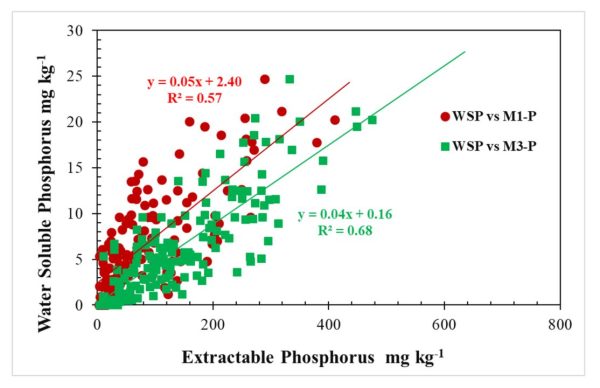Crop Production

Different soil test methods are used to determine total phosphorus available to crops as well as phosphorus that is susceptible to environmental loss. Learn the best methods to use for your soil group and crops.
Phosphorus (P) is one of the limiting nutrients for crop production in highly weathered soils. Low soil phosphorus concentration hinders crop growth and development and affects agronomic yield.
Achieving optimal yield requires a sufficient concentration of available phosphorus in the soil solution. By understanding the different methods used for phosphorus analysis and their use for agronomic and environmental purposes, you can more efficiently apply nutrients and prevent losses in the environment.
Soil Total Phosphorus
Soil total phosphorus refers to all forms of phosphorus present in soil. It includes organic phosphorus, phosphorus present in soil solution in labile organic and inorganic forms, phosphorus contained in insoluble mineral form, exchangeable phosphorus, and recalcitrant phosphorus. Soil total phosphorus can vary widely, ranging from less than 1 pound per acre to 6,000 pounds per acre.
The source of phosphorus in soil originates from naturally occurring minerals present in the lithosphere. These minerals weather in time and release phosphorus as orthophosphate ions (H2PO4–, HPO42-) that can be readily available to crops. Weathering is a very slow process and cannot be solely relied on for the availability of phosphate ions. Hence, the external application of phosphorus is important to support healthy crop growth.
Quantification of total soil phosphorus has limited implications for agronomic purposes since a small percent of the total phosphorus is available to the crop at any given time. Instead, extractable phosphorus is used most often for agronomic and environmental purposes.
Soil Extractable Phosphorus
Extractable phosphorus refers to the amount of phosphorus extracted from the soil using different extractants. The extractant can be water or chemicals, such as Mehlich-1, Mehlich-3, Lancaster, Bray, Olsen, etc. The decision on which extractant to be used depends on the purpose of use and the capacity of the extractant to accurately and reliably determine phosphorus concentration for a given soil type.
Extractable phosphorus is classified into different indices or categories and used to evaluate yield response to external phosphorus application rates. The information can be used for phosphorus fertilizer recommendations.
For Alabama soils, Mehlich-1 and Lancaster are used for agronomic purposes, such as determining the rate of external phosphorus application. Mehlich-3 and water have been the best methods for environmental purposes, such as evaluating phosphorus loss risk potential for a given soil type. Following are specifics about each extractant:
Mehlich-1. Also known as dilute double acid or North Carolina extractant, Mehlich-1 is composed of 0.05 molar hydrochloric acid and 0.0125 molar sulfuric acid solution. The extractant is best suited for noncalcareous acid soils (pH < 6.5) with low cation exchange capacity (CEC < 10 cmol kg-1) and low soil organic matter content (< 2%).
When used for soils with neutral or alkaline pH, freshly limed soils, or soils with high cation exchange capacity, Mehlich-1 loses its effectiveness to correctly extract phosphorus. This happens because the dilute acids in the Mehlich-1 get neutralized and reduce its ability to correctly extract phosphorus. The neutralization reaction can lead to an underestimation of extractable phosphorus and result in an erroneous interpretation of soil test results.
Lancaster. Suited for calcareous soils having pH ranges above 7, Lancaster is composed of 1.58 molar glacial acetic acid, 0.125 molar malonic acid, 0.187 molar malic acid, 0.037 molar ammonium fluoride, and 0.03 molar aluminum chloride hexahydrate.
The first step of extraction is to treat the soil with a weak acidic solution (0.05 molar hydrochloric acid) without agitation. This is followed by extraction with Lancaster extractant. This extractant is primarily used for the Blackbelt prairie soils of Alabama.
Mehlich-3. An improvement over Mehlich-1, Mehlich-3 was developed with the goal of enhancing the extraction of phosphorus, potassium, micronutrients, and other exchangeable cations. It is composed of 0.2 molar acetic acid, 0.015 molar ammonium fluoride, 0.013 molar nitric acid, 0.001M ethylenediaminetetraacetic acid and 0.25 molar ammonium nitrate.
Mehlich-3 is not used in Alabama for fertilizer recommendations. It can be used, however, for environmental evaluation of reactive phosphorus loss via runoff or leaching.
Water. By extracting the instantly available phosphorus in the soil, water is used to estimate soluble and easily desorbed phosphorus that can cause water-quality issues such as eutrophication. Water extraction is not used for agronomic purposes because water extracts only a small fraction of available phosphorus. However, it can be used to predict phosphorus concentration in runoff water during storm events.
Soil Extractable Phosphorus for Agronomic Purposes
Prior to using a specific extractant, extensive field calibration and verification are required. The process is time-consuming and requires evaluation at multiple sites over multiple years.
Mehlich-1 and Lancaster extractants are calibrated and validated for fertility recommendations in Alabama. Mehlich-1 is used for soil groups 1, 2, and 3, and Lancaster is used for soil group 4 (see table 1).
Upon extraction, soil is assigned one of six test ratings (very low, low, medium, high, very high, or extremely high) depending on the concentration of the extracted phosphorus. Table 1 provides the concentration ranges of each soil test category for Mehlich-1 and Lancaster for the four soil groups. Peanut, pine, centipede, and blueberry have different phosphorus requirements than other crops; therefore, those crops are assigned differently for the soil test phosphorus categories.
For soils categorized as high, very high, or extremely high in phosphorus, the likelihood of crop yield response to additional phosphorus is very low. For soils categorized as very low, low, or medium in phosphorus levels, phosphorus application will increase the potential yield by 50 to 100 percent.
Table 1a. Soil Test Phosphorus Ratings of Alabama Soil Groups and Crops – Peanut, Pine, Centipede, Blueberry
Soil group 2: Loamy and clayey soils with an ECEC of 4.6 to 9.0 cmolc kg-1 extracted with Mehlich-1
Soil group 3: Clayey soils from areas other than the Black Belt with an ECEC more than 9 cmolc kg-1 extracted with Mehlich-1
Soil group 4: Calcareous clayey soils of the Black Belt extracted with Mississippi/Lancaster extractant
| Rating | Soil Groups 1 & 2 | Soil Group 3 | Soil Group 4 | |
|---|---|---|---|---|
Soil Test Phosphorus lb/A | ||||
| Very low | 0-4 | 0-2 | 0-9 | |
| Low | 5-10 | 3-5 | 10-15 | |
| Medium | 11-19 | 6-11 | 16-27 | |
| High | 20-50 | 12-30 | 28-72 | |
| Very high | 51-250 | 31-150 | 73-360 | |
| Extremely high | 251+ | 151+ | 361+ | |
Table 1b. Soil Test Phosphorus Ratings of Alabama Soil Groups and Crops – All Other Crops
Soil group 2: Loamy and clayey soils with an ECEC of 4.6 to 9.0 cmolc kg-1 extracted with Mehlich-1
Soil group 3: Clayey soils from areas other than the Black Belt with an ECEC more than 9 cmolc kg-1 extracted with Mehlich-1
Soil group 4: Calcareous clayey soils of the Black Belt extracted with Mississippi/Lancaster extractant
| Rating | Soil Groups 1 & 2 | Soil Group 3 | Soil Group 4 | |
|---|---|---|---|---|
Soil Test Phosphorus lb/A | ||||
| Very low | 0-12 | 0-7 | 0-18 | |
| Low | 13-25 | 8-15 | 19-36 | |
| Medium | 26-50 | 16-30 | 37-72 | |
| High | 51-100 | 31-60 | 73-144 | |
| Very high | 101-250 | 61-150 | 145-360 | |
| Extremely high | 251+ | 151+ | 361+ | |
Soil Extractable Phosphorus for Environmental Purposes

Figure 1. Relationship between water-soluble phosphorus (WSP) with Mehlich-1 phosphorus (M1-P) and Mehlich-3 phosphorus (M3-P) for surface 0–5 cm soils.
Rising concerns around water quality from nonpoint sources has led to integration of soil testing as a tool in phosphorus loss risk assessment. For example, the Alabama phosphorus index is used by the National Resources Conservation Service (NRCS) to assess the vulnerability of the environment to phosphorus loss. The Alabama phosphorus index includes the soil test phosphorus level as one of the inputs in assigning phosphorus loss risk categories.
Inappropriate soil test results can be misinterpreted and lead to negative consequences. Research done on Alabama soils has identified Mehlich-3 as a more effective extractant than Mehlich-1 or Lancaster for environmental phosphorus loss risk determination. Mehlich-3 has been better correlated than Mehlich-1 with water-soluble phosphorus that is susceptible to runoff losses during storm events (figure 1).
Conclusion
Soil test methods vary in chemical composition as well the purpose they serve. The Mehlich-1 test is best suited for fertility recommendations in noncalcareous soils. The Lancaster test is best suited for fertility recommendations in calcareous soils. The Mehlich-3 test provides a better gauge for environmental phosphorus loss risk identification for all Alabama soil groups.
References
- Bhatta, A., R. Prasad, D. Chakraborty, J. N. Shaw, J. Lamba, E. Brantley, H. A. Torbert. 2021. “Mehlich 3 as a Generic Soil Test Extractant for Environmental Phosphorus Risk Assessment across Alabama Soil Regions.” Agrosystems, Geosciences & Environment 4, no. 3.
- Mitchell, C. C., and G. Huluka. 2012. “The Basis of Soil Testing in Alabama.” Agronomy and Soils Departmental Series No. 324A. Alabama Agricultural Experiment Station, Auburn University.
 Rishi Prasad, Extension Specialist, Assistant Professor, and Debolina Chakraborty, Research Fellow, both in Crop, Soil, and Environmental Sciences, Auburn University
Rishi Prasad, Extension Specialist, Assistant Professor, and Debolina Chakraborty, Research Fellow, both in Crop, Soil, and Environmental Sciences, Auburn University
New April 2022, Phosphorus Basics: Testing Soil Phosphorus for Agronomic and Environmental Purposes, ANR-2866

